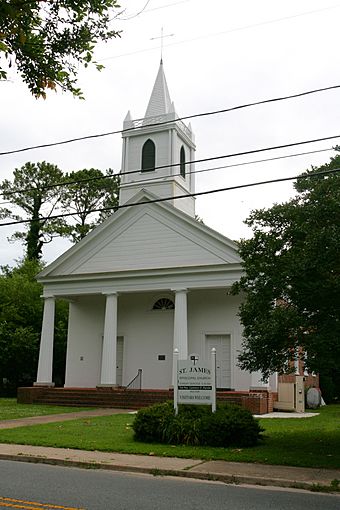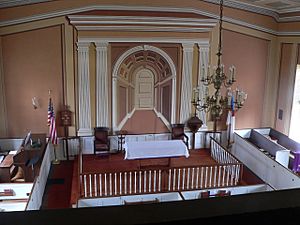St. James Church (Accomac, Virginia) facts for kids
|
St. James Church
|
|
|
U.S. Historic district
Contributing property |
|
 |
|
| Location | Drummontown Rd. between Back St. and Ocean Hwy., Accomac, Virginia |
|---|---|
| Area | less than one acre |
| Built | 1838 |
| Architect | Potts |
| Architectural style | Greek Revival |
| NRHP reference No. | 69000215 |
Quick facts for kids Significant dates |
|
| Added to NRHP | June 11, 1969 |
St. James Church is a historic Episcopal Church on Drummondtown Road near Back Street in Accomac, Virginia, United States. Originally established as a chapel of ease for Accomack Parish in the seventeenth century, the present St. James Church was erected in 1838 as the town then known as Drummondtown grew as the county seat (and renamed Accomac in 1892). In recognition of its Greek Revival design and interior trompe-l'oeil frescos, St. James Church was listed on the National Register of Historic Places in 1969. It is also a contributing building of the Accomac Historic District which was created in 1992.
Contents
History
Accomack Parish of the Anglican (Episcopal) Church was separated from Hungars Parish in 1663. St. James Church was originally established as a chapel of ease for Accomack Parish to serve congregants living in southeastern Accomack County. The original church, constructed of brick in Georgian style, was completed in 1767. It stood near the present-day town of Onley, Virginia. About twenty years after the construction of the first St. James Church, Drummondtown) was chartered by the Virginia General Assembly and established as the county seat for Accomack County. As the town developed in the early-19th century, St. James' parishioners decided to move their church closer to the county seat. Drummondtown had two thriving hotels, as well as a Methodist and Presbyterian churches, furniture and hat-making factories, stores and houses.
Land was purchased in 1838 and construction began with some bricks from the original church. The new church was designed in the popular Greek Revival style and laid out in the low-church style typical of Episcopal Churches in the first half of the nineteenth century. This plan can still be seen in the church today, which has two doors leading into two aisles inside the church and a central platform which was originally the site of the pulpit. A vesting room was constructed at the center of the back wall of the church. The vestry commissioned traveling artist Jean G. Potts to fresco the church's interior walls and ceiling. The artist, a master of the trompe-l'oeil ("fool the eye") style, created a chancel designed to make the church seem deeper, and also decorated the walls with simulated pilasters, moulding, and raised-panel walls.
The town flourished in the 1840s and by 1860 hosted the first newspaper published on the Eastern Shore. This was the home parish of Henry A. Wise, a prominent lawyer who served as U.S. Minister to Brazil, and Virginia's 33rd governor (from 1856 until 1860). His birthplace remains visible from the church's back lawn. Wise's first two wives came from Pennsylvania, and the sister of his second wife (who died of childbirth complications in 1850) married an army officer who became Union General George G. Meade. By 1853, Wise had moved to his third wife's estate near Norfolk. Governor Wise may be most famous for signing John Brown's death warrant, or for his secession oratory. Despite his lack of military training, Wise became a Confederate General (removed from his duties in the west in 1862 and reassigned to protect the southern Chesapeake Bay region, but who lost the Battle of Roanoke Island). Confederate General Wise continued to serve in North Carolina and Virginia until war's end, when he urged General Robert E. Lee to surrender at Appomattox Courthouse. After the war, Wise resumed his legal practice in Richmond.
While many other churches on the Eastern Shore of Virginia were severely damaged by occupying Union Army during the American Civil War, including nearby St. George's Church, St. James Church was spared. Union General Henry H. Lockwood listened to the urging of Accomac's citizens and kept his troops well-disciplined. Lockwood also took over a house abandoned by Dr. Peter Browne, which he made Union headquarters for construction of a telegraph line to Hampton Roads, and later became the rectory for this church's ministers.
Architecture
St. James Church is among the most pure representations of Greek Revival style to be found on Virginia's Eastern Shore. The brick walls are laid in 3-to-1 common bond both above and below the water table. The front (southwest) facade is covered with stucco and scored to resemble ashlar stone. The front facade is dominated by a tetrastyle portico of Doric order. A lunette window is centered in the front wall between the two sets of entrance doors. A wide wooden entablature with dentils extends across the front and sides of the church's walls. The gable roof is surmounted by a wooden belfry, constructed with Gothic Revival stylistic characteristics.
The church's interior is dominated by Potts' trompe-l'oeil frescoes which display various hues of brown, tan, and yellow. Two aisles lead from the entry doors to the chancel, which is surrounded by a simple altar rail with turned balusters. Original wooden bench-style pews with doors are still intact and are labeled with roman numerals. A gallery extends across the back of the nave, accessed by a unique split, flying staircase. Two flights of stairs ascend to a common landing from just inside the two entry doors, and then ascend a flying staircase into the gallery. Eight large windows, four on each side, with double hung four-over-four sashes of clear glass light the nave. The walls are frescoed beginning at the tops of the pews and extending all the way to the ceiling. Potts decorated the side walls of the nave with pilasters and moulding which frame the windows. In the chancel, Potts created a portico of four square, fluted pilasters framing a paneled recess, framed by a barrel vault in the center. The shallow barrel-vaulted ceiling is frescoed with panels, moulding, and plaster medallions. At the center of the ceiling, Potts frescoed a round medallion above the chandelier featuring a brilliant blue color, which appears especially striking contrasting with the subdued colors used in the rest of the frescoes. In the 20th century, Linda Croison and Philip Ward restored the frescoes, but preserved patches of Potts' original work in the back of the nave.
Modern times
St. James remains an active congregation in the Episcopal Diocese of Southern Virginia and helps lead its racial reconciliation efforts. It now shares a rector, Rev. Cameron Randle, with another historic church nearby, St. George's Church in Pungoteague.
Gallery











